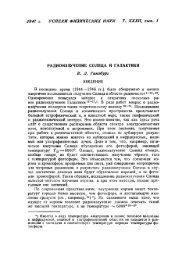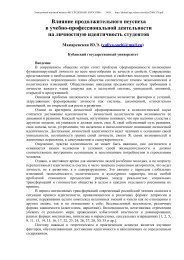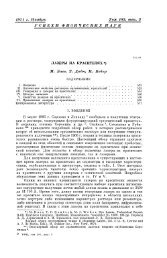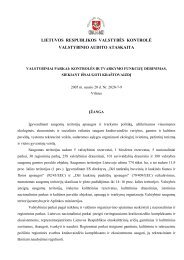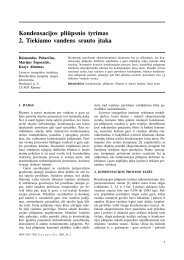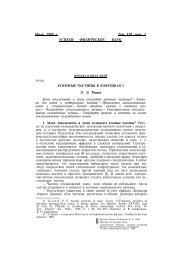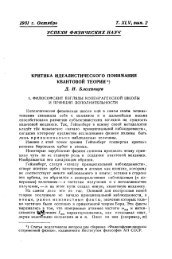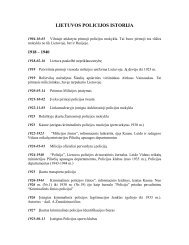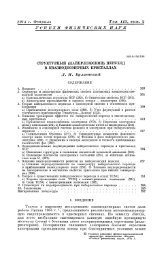University of Groningen Groningen Growth and Development Centre ...
University of Groningen Groningen Growth and Development Centre ...
University of Groningen Groningen Growth and Development Centre ...
You also want an ePaper? Increase the reach of your titles
YUMPU automatically turns print PDFs into web optimized ePapers that Google loves.
productivity decline was observed in textiles <strong>and</strong> clothing. The Mexican time series produce more<br />
plausible results than those <strong>of</strong> Mexico, partly because <strong>of</strong> the availability <strong>of</strong> long run time series <strong>of</strong> the<br />
national accounts for value added <strong>and</strong> employment.<br />
An important question is whether the differences in growth rates between Brazil <strong>and</strong> the USA<br />
in textiles <strong>and</strong> clothing, machinery <strong>and</strong> transport equipment are real or due to inconsistencies in the<br />
time series. For this purpose it is useful to check the plausibility <strong>of</strong> the time series by using them to<br />
backdate our 1985 benchmark estimates to 1975, which is the year for which the first benchmark<br />
comparison was made between Brazil <strong>and</strong> the USA by van Ark <strong>and</strong> Maddison (1994). 7 The<br />
extrapolated productivity result from 1985 to 1975 was 56 per cent <strong>of</strong> the US level, which was 7.5<br />
percentage points higher than the result <strong>of</strong> Maddison <strong>and</strong> van Ark. Although the results for food<br />
products <strong>and</strong> basic metals <strong>and</strong> metal products were close, those for the other branches show major<br />
discrepancies. This seriously questions the validity <strong>of</strong> the Brazilian time series.<br />
Table 7<br />
Extrapolation <strong>of</strong> Relative Productivity Levels to 1975 <strong>and</strong><br />
Comparison with Results <strong>of</strong> van Ark <strong>and</strong> Maddison (USA=100)<br />
Brazil<br />
Mexico<br />
1985 1975 1988 1975<br />
Extrapolated van Ark <strong>and</strong> Extrapolated van Ark <strong>and</strong><br />
Maddison<br />
Maddison<br />
Food, Beverages <strong>and</strong> Tobacco 43.9 52.5 56.6 25.5 33.9 36.1<br />
Textiles <strong>and</strong> Clothing 52.7 100.6 52.5 33.4 60.5 38.2<br />
Wood, Paper <strong>and</strong> Publishing 28.3 16.2 28.6 22.3 22.5 22.3<br />
Chemicals 32.6 39.2 66.6 31.0 40.0 39.3<br />
Basic Metal <strong>and</strong> Metal Products 50.8 47.5 42.4 29.4 35.4 42.8<br />
Machinery, Equipment (except Transport) 55.3 99.8 17.5 22.8<br />
51.6<br />
Transport Equipment 55.9 72.2<br />
50.8 69.8<br />
31.3<br />
Other manufacturing 41.3 80.8 39.0 18.9 42.6 29.2<br />
Total Manufacturing 42.5 56.0 48.5 27.4 37.6 37.1<br />
Sources: benchmark results from Table 6, extrapolations based on time series as described in Figure 1.<br />
The same exercise was carried out for the Mexico/USA comparison, see the right h<strong>and</strong> side <strong>of</strong> the table. In contrast<br />
to the Brazil/USA comparison, the extrapolated results for Mexico from 1988 to 1975 are very close to those <strong>of</strong> van<br />
Ark <strong>and</strong> Maddison. This finding holds for total manufacturing, as well as most branches except textiles <strong>and</strong><br />
clothing <strong>and</strong> other manufacturing.<br />
8. Unit Labour costs<br />
Relative productivity levels are an important determinant <strong>of</strong> international competitiveness. However,<br />
some countries may not be h<strong>and</strong>icapped by low productivity if at the same time labour compensation<br />
is also low. The net result <strong>of</strong> relative productivity <strong>and</strong> relative remuneration is expressed by the<br />
concept <strong>of</strong> unit labour costs. It divides the labour compensation in Brazil or Mexico relative to the<br />
USA by the labour productivity in Brazil or Mexico relative to the USA:<br />
ULC<br />
( W N )<br />
x<br />
⎛ ⎞<br />
⎜<br />
P<br />
⎝ NER ⎟⎟ P $ ⎠<br />
( W N )<br />
USA<br />
xu $<br />
=<br />
RLPE<br />
(18)<br />
7 It should be stressed that even with exactly the same sources, extrapolated estimates will never exactly compare<br />
with benchmark results for the corresponding year, because <strong>of</strong> inconsistencies in index numbers.<br />
20




